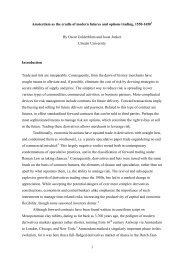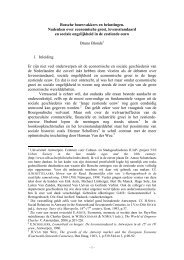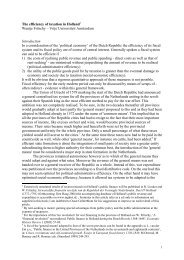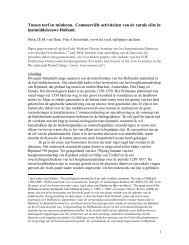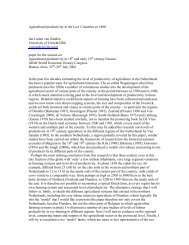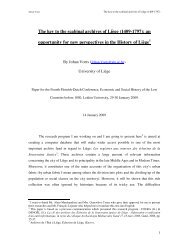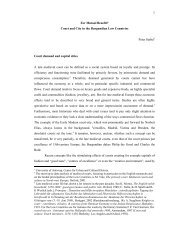Justyna Wubs-Mrozewicz LOOKING TWICE - Economy and Society ...
Justyna Wubs-Mrozewicz LOOKING TWICE - Economy and Society ...
Justyna Wubs-Mrozewicz LOOKING TWICE - Economy and Society ...
You also want an ePaper? Increase the reach of your titles
YUMPU automatically turns print PDFs into web optimized ePapers that Google loves.
Looking twice, <strong>Justyna</strong> <strong>Wubs</strong>-<strong>Mrozewicz</strong> January 2009<br />
fishermen. 68 The fact that Hansards could provide the desired grain (along with other<br />
products), ensured them not only the right of winter residence, but also the grip on the<br />
stockfish which was to be exported via Bergen. It was also the explanation Hanseatic traders<br />
gave for their stronghold in Bergen. With their ships filled with Baltic grain, they considered<br />
themselves indispensable to Norway. 69 Already in the 1240s the Norwegian king requested<br />
that Lübeckers send goods which the country needed, namely grain <strong>and</strong> malt. 70 Later the<br />
Norwegian rulers twice explicitly stressed the benefits Hanseatic import of grain provided. 71<br />
Moreover, they gave their support to the credit system <strong>and</strong> admonished their subjects to fulfil<br />
the duties they had accepted by taking the Hanseatic credit, namely providing the fish to<br />
specific merchants. 72 Hansards themselves were keen to keep total control on the channelling<br />
of fish from northern Norway, the tributary isl<strong>and</strong>s <strong>and</strong> Icel<strong>and</strong> through Bergen <strong>and</strong> their<br />
Kontor. They established own rules on how the exchange of grain against stockfish was to<br />
take place, amongst others allowing only winter residents (<strong>and</strong> not summer guests) direct<br />
trade with the fishermen. Trespasses were punished severely. 73 Guests, who were thus not<br />
permanent residents of the Kontor, were to buy the stockfish from residents. In no case were<br />
they allowed to fetch the fish themselves from northern Norway. The credit system was put<br />
under serious strain when Hanseatic non-residents of the Kontor started trading directly with<br />
Icel<strong>and</strong> in the first half of the fifteenth century, 74 <strong>and</strong> with northern Norway <strong>and</strong> the tributary<br />
isl<strong>and</strong>s in the sixteenth century. The latter happened often after Hansards left the Kontor <strong>and</strong><br />
became Bergen burghers. 75<br />
What kind of impact did the credit system of the Hanseatic Kontor have on Holl<strong>and</strong>ers<br />
in Bergen? In a number of ways, it made them outsiders in the Bergen fish trade. First of all,<br />
68<br />
Nedkvitne, Utenriksh<strong>and</strong>elen, pp. 268-278; Helle, Bergen I, pp. 734-338; Schreiner, Hanseatene og Norge, pp.<br />
18-21.<br />
69<br />
1476, NGL II/2 pp. 737-738 (HR II/7 nr. 342) § 24: ‘wente dat lant unde de Normans sunder sware gudere uth<br />
den Osterschen steden sick nenerleye mogen untholden’ (because this country <strong>and</strong> Norwegians cannot in any<br />
way do without grain products from the Baltic towns); Bruns, Bergenfahrer, p. LI.<br />
70<br />
DN 5 nr. 1 (1247-1248).<br />
71<br />
1469, NGL II/2 nr. 121; 1560, NRR 1 p. 297; Schreiner, Hanseatene og Norge, p. 295.<br />
72<br />
For the royal regulations supporting the Hanseatic credit system, see for instance 1350, DN 3 nr. 272; 1398,<br />
NGL II/1 pp. 40-41; 1447 NGL II/1 nr. 140 (HR II/3 nr. 311) §§ 11, 21 pp. 290, 292; 1513, NGL II/4 nr. 4 (HR<br />
III/6 nr. 508) §§ 4, 9.<br />
73<br />
NGL II/2 pp. 727-728 (DN 6 nr. 566; HR II/6 nr. 186) § 2; NGL II/2 pp. 732-733 (DN 6 nr. 568; HR II/6 nr.<br />
188) note 2 <strong>and</strong> §§ 1-5; NGL II/2 pp. 732-734 (DN 6 nr. 568; HR II/6 nr. 188) § 1; NGL II/2 pp. 739-742 (HR<br />
II/7 nr. 343) § 2;<br />
74<br />
Especially traders from Hamburg <strong>and</strong> Bremen, for instance HR III/1 nr. 351 <strong>and</strong> 510; HR III/6 nr. 515; HR<br />
III/7 nr. 246 §§ 94-96; HR III/9 nr. 131 § 161; NGL II/1 nr. 377; NGL II/1 nr 385; DN 20 nr. 789. See also E.<br />
Baasch, Forschungen zur hamburgischen H<strong>and</strong>elsgeschichte. I. Die Isl<strong>and</strong>fahrt der Deutschen, namentlich der<br />
Hamburger, vom 15. bis 17. Jahrhundert (Hamburg 1889) <strong>and</strong> B.E. Gelsinger, Icel<strong>and</strong>ic enterprise. Commerce<br />
<strong>and</strong> economy in the Middle Ages (Columbia S.C. 1981).<br />
75<br />
NGL II/3 p. 107 (HR III/2 nr. 160) § 165; AHL, Bergenfahrer nr. 1427 <strong>and</strong> 452; NRR 1 p. 101; Fossen,<br />
Bergen II, pp. 43-45.<br />
10



